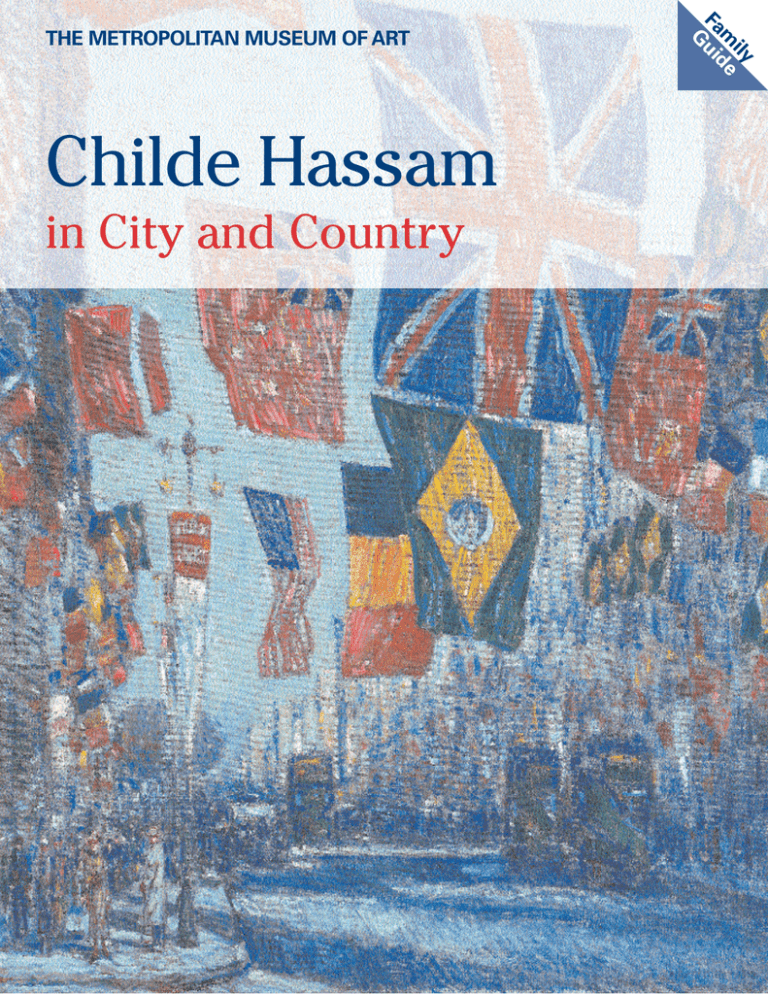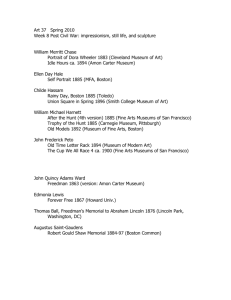Childe Hassam in City and Country
advertisement

Childe Hassam in City and Country ily m de Fa ui G THE METROPOLITAN MUSEUM OF ART Winter in Union Square Celia Thaxter’s Garden B B Childe Hassam in his New York studio, about 1896. (Courtesy Carnegie Museum of Art.) About the Artist Frederick Childe Hassam (1859–1935) was born in Dorchester (now part of eginning in the lower left-hand corner of this painting, let your eyes follow along the path to the buildings in the distance. What appears to be moving in this scene, and what is still? Where do you see the color red used? How would you like to travel through this park, by trolley, carriage, or on foot? Although Central Park, The Metropolitan Museum of Art, and the American Museum of Natural History were all open to the public by 1890, the center of New York City was still below Thirty-fourth Street. Union Square Park, between Fourteenth and Seventeenth Streets, was a destination for entertainment and shopping. This painting captures the snow-covered park from a high vantage point looking south from the corner of Seventeenth Street and Broadway. On Fourteenth Street are the Morton House Hotel, on the left, and the domed Domestic Sewing Machine Company, toward the right. Barely visible between them is the spire of Grace Church at Tenth Street. The park’s statues are seen amidst the trees. From 1889 to 1892, Hassam worked in a studio at 95 Fifth Avenue, one block west of Union Square. The park, its fashionable visitors, and the activities of a modern city were favorite subjects of his. Boston), Massachusetts. The name Celia Thaxter’s Garden, Isles of Shoals, Maine, 1890; oil on canvas; 173/4 x 211/2 in.; The Metropolitan Museum of Art, New York, Anonymous Gift, 1994 (1994.567) Avenue of the Allies S tart by looking at the farthest building and slowly move your eyes to the flags hanging closest to you. How many flags do you see? What season and time of day is it? Is there a breeze blowing? Can you identify the countries that the flags represent? During World War I, the blocks along Fifth Avenue from Forty-second Street to Fifty-ninth Street in New York City displayed flags of the twenty-two allied countries. The numerous colorful flags were meant to encourage people to support the American war effort. For this canvas, Hassam stood at Fifty-third Street looking north and painted the flags on three blocks into a colorful pattern of rectangles, stripes, triangles, circles, and diamonds. Hassam created more than thirty flag paintings, which became some of his most popular works. The flags here include those of Great Britain (largest), New Zealand (to the left), Canada (the flag used before 1965, to the right), Brazil (with diamond shape), and Belgium (black, yellow, and red stripes). Hassam (pronounced HASS-am) comes from the English name Horsham. At the age of twenty-seven Hassam traveled to France, studied there for three years, and was inspired by an art movement known as Impressionism. He settled in Manhattan in 1889 and became New York’s most successful painter working in the Impressionist style. He used quick, short, and overlapping strokes of paint to capture moments in everyday life, often from unusual points of view. Hassam created more than 2,000 works in oil, pastel, and watercolor and more than 400 prints. Let’s take a look at three paintings by Childe Hassam. Winter in Union Square, 1889–90; oil on canvas; 181/4 x 18 in.; The Metropolitan Museum, New York, Gift of Ethelyn McKinney, in memory of her brother, Glenn Ford McKinney, 1943 (43.116.2) egin looking at the bottom of the painting and slowly scan up. What do you imagine you might hear, smell, and feel in this garden? Where do you see shades of blue repeated? Can you name any of the flowers? Between 1886 and 1916, Hassam worked and relaxed on an island called Appledore off the coast of New Hampshire. He would stay at the cottage of his friend, the poet Celia Thaxter, who helped her family manage a hotel on the island. Hassam often painted the lovely old-fashioned garden that Thaxter planted outside her cottage. She deliberately designed her garden to look as if it grew wild by the sea. Hassam carefully chose this closeup view so the flowers cover two-thirds of the canvas and we peek past them at the brilliant blue ocean, sun-drenched rocks, and pale summer sky. The flowers include red poppies, blue larkspur, white lilies, and purple hollyhocks. Avenue of the Allies, Great Britain, 1918, 1918; oil on canvas; 36 x 283/8 in.; The Metropolitan Museum of Art, New York, Bequest of Miss Adelaide Milton de Groot (1876–1967), 1967 (67.187.127) Open here for your keepsake poster! FUN ON THE WEB MORE TO EXPLORE Be sure to check out our special feature about Childe Hassam: www.metmuseum.org/explore/childe_hassam/index.html NOW IT’S YOUR TURN! Sketch a cityscape or country view below. Will your picture be horizontal or vertical? What season and time of day are you going to choose? Where will you stand or sit to draw your scene? Education The Metropolitan Museum of Art 1000 Fifth Avenue New York, NY 10028-0198 www.metmuseum.org ©2004 by The Metropolitan Museum of Art You can find other Impressionist paintings in The American Wing and in the Nineteenth-Century European Paintings galleries in the Museum. Childe Hassam, American Impressionist June 10–September 12, 2004 This family guide is made possible by THE PETER JAY SHARP FOUNDATION. The exhibition is made possible by THE PETER JAY SHARP FOUNDATION and THE BANK OF NEW YORK. Additional support has been provided by the Marguerite and Frank A. Cosgrove Jr. Fund. Childe Hassam The Metropolitan Museum of Art Childe Hassam (American, 1859–1935), Avenue of the Allies, Great Britain, 1918, 1918; oil on canvas; 36 x 283/8 in.; The Metropolitan Museum of Art, New York, Bequest of Miss Adelaide Milton de Groot (1876–1967), 1967 (67.187.127)

